Generation of Millimeter Waves and Sub-Terahertz Waves Using a Two-Wavelength Tunable Laser for a Terahertz Wave Transceiver
Abstract
:1. Introduction
2. Principle and Structure
2.1. Structure of a TWTL
2.2. Design Values for Each Structure
2.2.1. Ring Resonator
2.2.2. Distributed Bragg Reflector (DBR)
2.2.3. Mach–Zehnder Interferometer (MZI)
3. Experiment
3.1. Wavelength Tuning Characteristics
3.2. L–I Characteristics
3.3. Millimeter Wave Generation
3.4. THz Wave Generation
4. Discussion
5. Conclusions
Author Contributions
Funding
Institutional Review Board Statement
Informed Consent Statement
Data Availability Statement
Acknowledgments
Conflicts of Interest
References
- Rappaport, T.S.; Xing, Y.; Kanhere, O.; Ju, S.; Madanayake, A.; Mandal, S.; Alkhateeb, A.; Trichopoulos, G.C. Wireless communications and applications above 100 GHz: Opportunities and challenges for 6G and beyond. IEEE Access 2019, 7, 78729–78757. [Google Scholar] [CrossRef]
- Nagatsuma, T. Terahertz technologies: Present and future. IEICE Electron. Express 2011, 8, 1127–1142. [Google Scholar] [CrossRef]
- Nagatsuma, T.; Horiguchi, S.; Minamikata, Y.; Yoshimizu, Y.; Hisatake, S.; Kuwano, S.; Yoshimoto, N.; Terada, J.; Takahashi, H. Terahertz wireless communications based on photonics technologies. Opt. Express 2013, 21, 23736–23747. [Google Scholar] [CrossRef] [PubMed]
- Kim, J.-Y.; Nishi, H.; Song, H.J.; Fukuda, H.; Yaita, M.; Hirata, A.; Ajito, K. Compact and stable THz vector spectroscopy using silicon photonics technology. Opt. Express 2014, 22, 7178–7185. [Google Scholar] [CrossRef] [PubMed]
- Li, B.; Ye, S.; Che, M.; Tang, H.; Masutomi, N.; Mikami, Y.; Kato, K. Demonstration of THz frequency hopping in the 300 GHz band based on UTC-PD and tunable DFB laser array. Jpn. J. Appl. Phys. 2024, 63, 04SP86. [Google Scholar] [CrossRef]
- Kita, T.; Matsumoto, A.; Yamamoto, N.; Yamada, H. Tunable dual-wavelength heterogeneous quantum dot laser diode with a silicon external cavity. J. Light. Technol. 2018, 36, 219–224. [Google Scholar] [CrossRef]
- Masuda, W.; Iwanaga, K.; Matsumoto, A.; Kita, T. C-band tunable dual-wavelength laser with a quantum dot SOA. In Proceedings of the IEEE International Semiconductor Laser Conference, Potsdam, Germany, 10–14 October 2021. [Google Scholar] [CrossRef]
- Huang, X.; Doerr, C.R.; Qin, C.; Heanue, J.; Zhu, N.; Ton, D.; Guan, B.; Zhang, S.; Zhao, Y. Silicon-photonic laser emitting tunable dual wavelengths with highly correlated phase noise. Opt. Lett. 2021, 46, 142–145. [Google Scholar] [CrossRef] [PubMed]
- Kim, C.; Kim, I.; Li, G.; Lange, M.R.; Dimmick, T.E.; Langlois, P.; Reid, B. Optical Microwave/Millimeter-Wave Links Using Direct Modulation of Two-Section Gain-Coupled DFB Lasers. IEEE Photonics Technol. Lett. 2005, 17, 1734–1736. [Google Scholar] [CrossRef]
- Kim, N.; Shin, J.; Sim, E.; Lee, C.W.; Yee, D.-S.; Jeon, M.Y.; Jang, Y.; Park, K.H. Monolithic dual-mode distributed feedback semiconductor laser for tunable continuous-wave terahertz generation. Opt. Express 2009, 17, 13851–13859. [Google Scholar] [CrossRef]
- Fice, M.J.; Rouvalis, E.; van Dijk, F.; Accard, A.; Lelarge, F.; Renaud, C.C.; Carpintero, G.; Seeds, A.J. 146-GHz millimeter-wave radio-over-fiber photonic wireless transmission system. Opt. Express 2012, 20, 1769–1774. [Google Scholar] [CrossRef]
- Elwan, H.H.; Khayatzadeh, R.; Poette, J.; Cabon, B. Impact of Relative Intensity Noise on 60-GHz Radio-Over-Fiber Wireless Transmission Systems. J. Light. Technol. 2016, 34, 4751–4757. [Google Scholar] [CrossRef]
- Rahim, M.; Zeb, K.; Lu, Z.; Pakulski, G.; Liu, J.; Poole, P.; Song, C.; Barrios, P.; Jiang, W.; Zhang, X. Monolithic InAs/InP quantum dash dual-wavelength DFB laser with ultra-low noise common cavity modes for millimeter-wave applications. Opt. Express 2019, 27, 35368–35375. [Google Scholar] [CrossRef]
- Lu, Z.; Liu, J.; Mao, Y.; Zeb, K.; Liu, G.; Poole, P.J.; Weber, J.; Rahim, M.; Pakulski, G.; Song, C.; et al. Quantum dash multi-wavelength lasers for Tbit/s coherent communications and 5G wireless networks. J. Eur. Opt. Soc. Rapid Publ. 2021, 17, 9. [Google Scholar] [CrossRef]
- Zeb, K.; Lu, Z.; Liu, J.; Mao, Y.; Liu, G.; Poole, P.J.; Rahim, M.; Pakulski, G.; Barrios, P.; Vachon, M.; et al. Broadband Optical Heterodyne Millimeter-Wave-over-Fiber Wireless Links Based on a Quantum Dash Dual-Wavelength DFB Laser. J. Light. Technol. 2022, 40, 3698–3708. [Google Scholar] [CrossRef]
- Zhu, X.; La, X.; Guo, J.; Li, Z.; Zhao, L.; Wang, W.; Liang, S. A Novel High Speed Directly Modulated Dual Wavelength 1.3 µm DFB Laser for THz Communications. IEEE J. Sel. Top. Quantum Electron. 2023, 29, 1500306. [Google Scholar] [CrossRef]
- Nishimoto, K.; Minoshima, K.; Yasui, T.; Kuse, N. Generation of a microresonator soliton comb via current modulation of a DFB laser. OSA Contin. 2020, 3, 3218–3224. [Google Scholar] [CrossRef]
- Nishimoto, K.; Minoshima, K.; Yasui, T.; Kuse, N. Investigation of the phase noise of a microresonator soliton comb. Opt. Express 2020, 28, 19295–19303. [Google Scholar] [CrossRef]
- Bustos-Ramirez, R.; Trask, L.R.; Bhardwaj, A.; Hoefler, G.E.; Kish, F.A.; Delfyett, P.J. Optical synchronization between a 300 GHz frequency comb and a 10 GHz chip-scale MLL. In Proceedings of the IEEE Photonics Conference, IPC 2020, Rome, Italy, 10–14 November 2020; p. 9252549. [Google Scholar] [CrossRef]
- Kuse, N.; Navickaite, G.; Geiselmann, M.; Yasui, T.; Minoshima, K. Frequency-scanned microresonator soliton comb with tracking of the frequency of all comb modes. Opt. Lett. 2021, 46, 3400–3403. [Google Scholar] [CrossRef]
- Shirpurkar, C.; Bustos-Ramirez, R.; Trask, L.; Pericherla, S.; Briles, T.C.; Stone, J.R.; Yu, S.P.; Bhardwaj, A.; Hoefler, G.E.; Papp, S.B.; et al. Optical Synchronization between mmWave comb sources and a 10 GHz chip-scale mode-locked laser photonic integrated circuit. In Proceedings of the International Topical Meeting on Microwave Photonics, MWP 2021, Pisa, Italy, 15–17 November 2021. [Google Scholar] [CrossRef]
- Kuse, N.; Nishimoto, K.; Tokizane, Y.; Okada, S.; Navickaite, G.; Geiselmann, M.; Minoshima, K.; Yasui, T. Low phase noise THz generation from a fiber-referenced Kerr microresonator soliton comb. Commun. Phys. 2022, 5, 312. [Google Scholar] [CrossRef]
- Nishimoto, K.; Minoshima, K.; Yasui, T.; Kuse, N. Thermal control of a Kerr microresonator soliton comb via an optical sideband. Opt. Lett. 2022, 47, 281–284. [Google Scholar] [CrossRef]
- Matsumura, Y.; Tokizane, Y.; Hase, E.; Kuse, N.; Minamikawa, T.; Fujikata, J.I.; Kishikawa, H.; Haraguchi, M.; Okamura, Y.; Kaji, T.; et al. Carrier conversion from terahertz wave to dual-wavelength near-infrared light for photonic terahertz detection in wireless communication. Opt. Express 2023, 31, 33103–33112. [Google Scholar] [CrossRef] [PubMed]
- Chu, T.; Fujioka, N.; Ishizaka, M. Compact, lower-power-consumption wavelength tunable laser fabricated with silicon photonic-wire waveguide micro-ring resonators. Opt. Express 2009, 17, 14063–14068. [Google Scholar] [CrossRef]
- Fujioka, N.; Chu, T.; Ishizaka, M. Compact and low power consumption hybrid integrated wavelength tunable laser module using silicon waveguide resonators. J. Light. Technol. 2010, 28, 3115–3120. [Google Scholar] [CrossRef]
- Verdier, A.; de Valicourt, G.; Brenot, R.; Debregeas, H.; Dong, P.; Earnshaw, M.; Carrere, H.; Chen, Y.K. Ultrawideband wavelength-tunable hybrid external-cavity lasers. J. Light. Technol. 2018, 36, 37–43. [Google Scholar] [CrossRef]
- Nemoto, K.; Kita, T.; Yamada, H. Narrow-spectral-linewidth wavelength-tunable laser diode with Si wire waveguide ring resonators. Appl. Phys. Express 2012, 5, 082701. [Google Scholar] [CrossRef]
- Kita, T.; Tang, R.; Yamada, H. Narrow spectral linewidth silicon photonic wavelength tunable laser diode for digital coherent communication system. IEEE J. Select. Top. Quantum Electron. 2016, 22, 1500612. [Google Scholar] [CrossRef]
- Guan, H.; Novack, A.; Galfsky, T.; Ma, Y.; Fathololoumi, S.; Horth, A.; Huynh, T.N.; Roman, J.; Shi, R.; Caverley, M.; et al. Widely tunable, narrow-linewidth III-V/silicon hybrid external-cavity laser for coherent Communication. Opt. Express 2018, 26, 7920–7933. [Google Scholar] [CrossRef]
- Bogaerts, W.; De Heyn, P.; Van Vaerenbergh, T.; De Vos, K.; Kumar Selvaraja, S.K.; Claes, T.; Dumon, P.; Bienstman, P.; Van Thourhout, D.; Baets, R. Silicon microring resonators. Laser Photonics Rev. 2012, 6, 47–73. [Google Scholar] [CrossRef]
- Park, I.; Fischer, I.; Elsäßer, W. Highly nondegenerate four-wave mixing in a tunable dual-mode semiconductor laser. Appl. Phys. Lett. 2004, 84, 5189–5191. [Google Scholar] [CrossRef]
- Thoen, E.R.; Koontz, E.M.; Joschko, M.; Langlois, P.; Schibli, T.R.; Kärtner, F.X.; Ippen, E.P.; Kolodziejski, L.A. Two-photon absorption in semiconductor saturable absorber mirrors. Appl. Phys. Lett. 1999, 74, 3927–3929. [Google Scholar] [CrossRef]
- Henry, C.H. Theory of the linewidth of semiconductor lasers. IEEE J. Quantum Electron. 1982, 18, 259–264. [Google Scholar] [CrossRef]
- Wei, M.; Ma, H.; Sun, C.; Zhong, C.; Ye, Y.; Zhang, P.; Liu, R.; Li, J.; Li, L.; Tang, B.; et al. TDFA-Band Silicon Optical Variable Attenuator. Prog. Electromagn. Res. 2022, 174, 33–42. [Google Scholar] [CrossRef]
- Taiichi, O. 40-Gbit/s InP-based HEMT IC technology for future Lightwave communication systems. In Proceedings of the Annual Device Research Conference Digest, Charlottesville, VA, USA, 22–24 June 1998; pp. 4–5. [Google Scholar]
- Satou, A.; Otsuji, T. Recent Advances of Grating-Gate Transistors for Fast, Sensitive, Room-Temperature Plasmonic Terahertz Detection. In Proceedings of the IEEE Photonics Society Summer Topicals Meeting Series, SUM 2022, Cabo San Lucas, Mexico, 11–13 July 2022. [Google Scholar] [CrossRef]
- Satou, A.; Negoro, T.; Narita, K.; Hosotani, T.; Tamura, K.; Tang, C.; Lin, T.T.; Retaux, P.E.; Takida, Y.; Minamide, H.; et al. Gate-readout and a 3D rectification effect for giant responsivity enhancement of asymmetric dual-grating-gate plasmonic terahertz detectors. Nanophotonics 2023, 12, 4283–4295. [Google Scholar] [CrossRef]
- Tsung-Tse, L.; Mitsuki, W.; Dai, N.; Keisuke, K.; Masato, Y.; Tetsuya, S.; Taiichi, O.; Akira, S. Efficient optical-to-sub-THz carrier frequency down-conversion by UTC-PD-integrated HEMT. In Proceedings of the International Topical Meeting on Microwave Photonics, MWP 2023, Nanjing, China, 15–18 October 2023. [Google Scholar] [CrossRef]

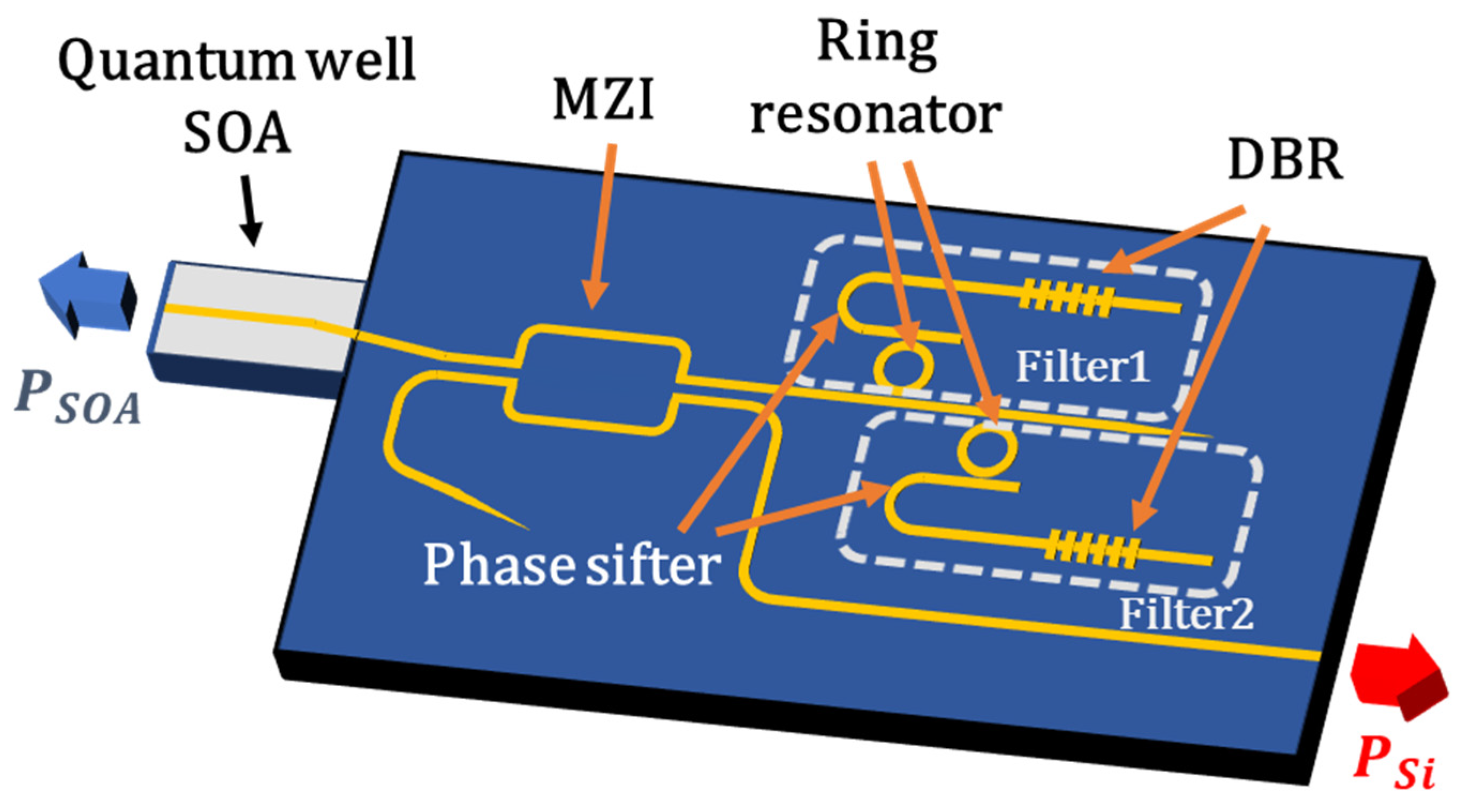

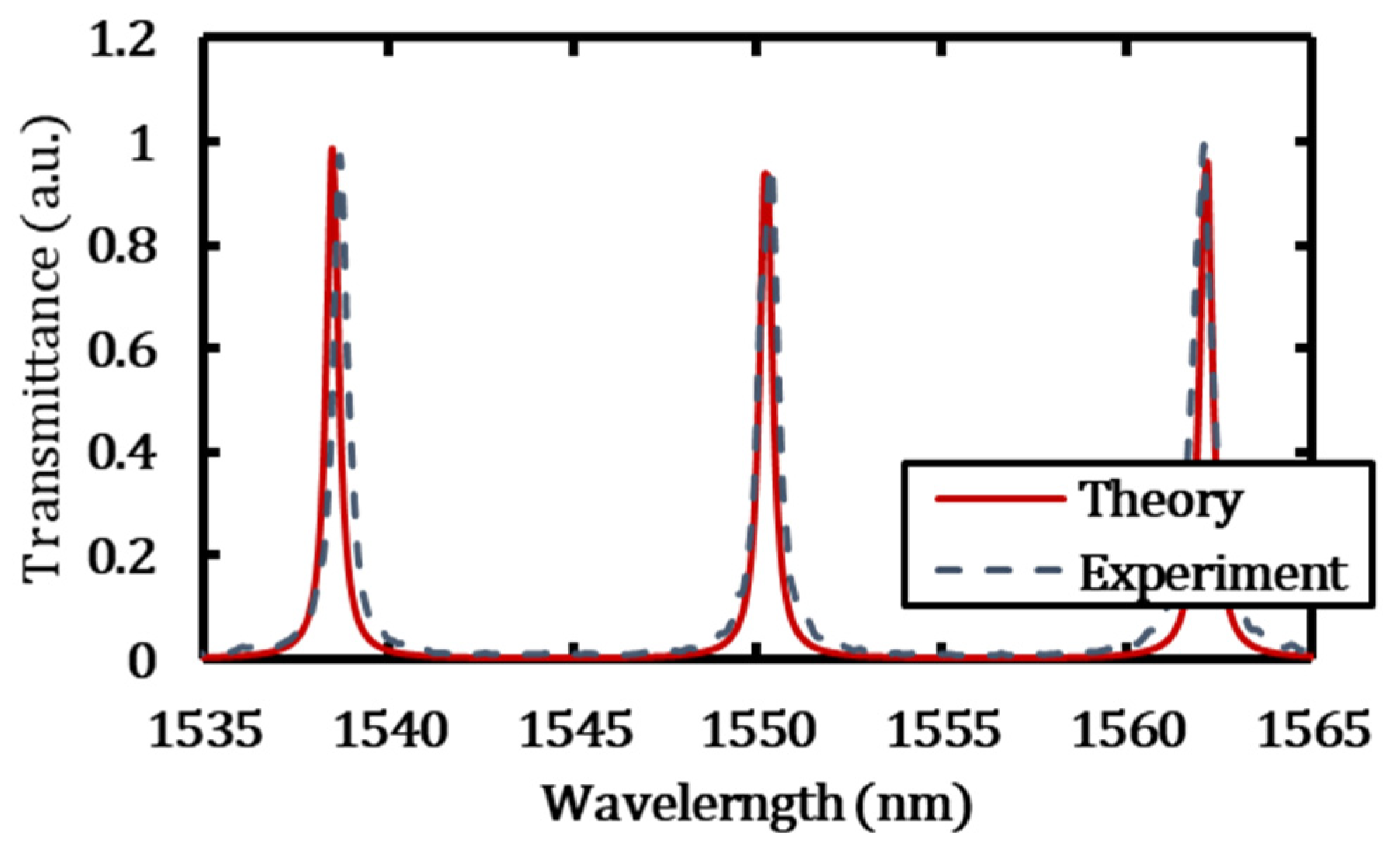




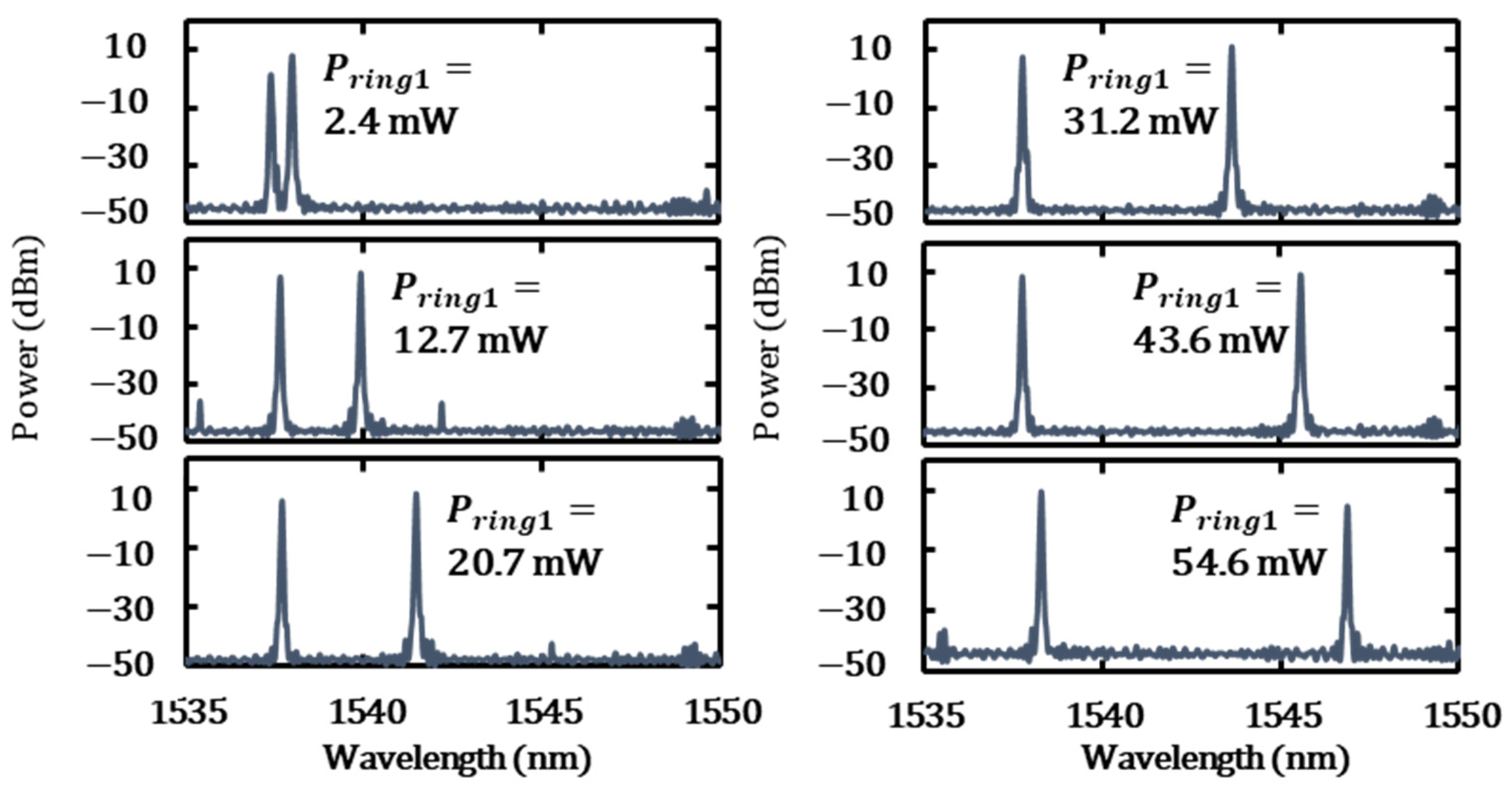





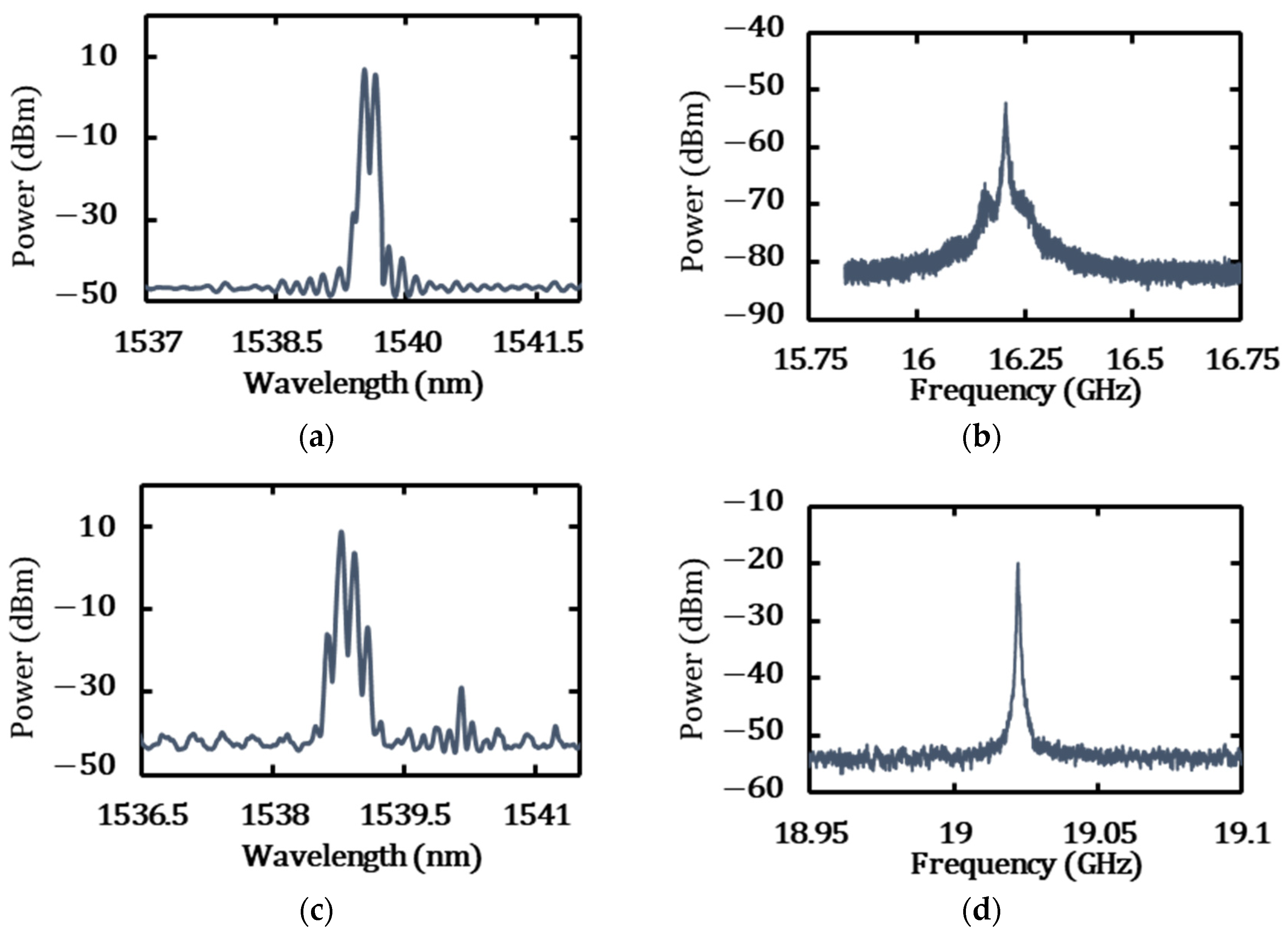



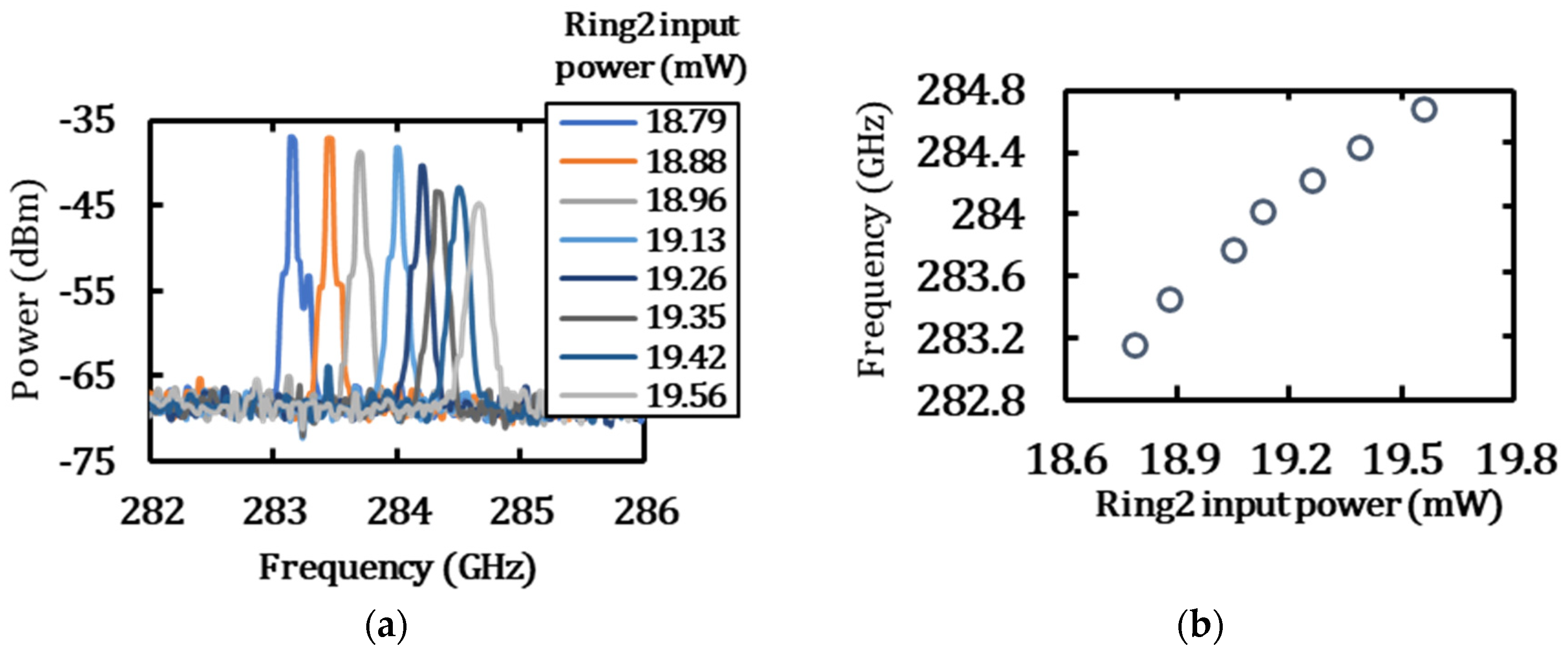
Disclaimer/Publisher’s Note: The statements, opinions and data contained in all publications are solely those of the individual author(s) and contributor(s) and not of MDPI and/or the editor(s). MDPI and/or the editor(s) disclaim responsibility for any injury to people or property resulting from any ideas, methods, instructions or products referred to in the content. |
© 2024 by the authors. Licensee MDPI, Basel, Switzerland. This article is an open access article distributed under the terms and conditions of the Creative Commons Attribution (CC BY) license (https://creativecommons.org/licenses/by/4.0/).
Share and Cite
Tomimura, Y.; Satou, A.; Kita, T. Generation of Millimeter Waves and Sub-Terahertz Waves Using a Two-Wavelength Tunable Laser for a Terahertz Wave Transceiver. Photonics 2024, 11, 811. https://doi.org/10.3390/photonics11090811
Tomimura Y, Satou A, Kita T. Generation of Millimeter Waves and Sub-Terahertz Waves Using a Two-Wavelength Tunable Laser for a Terahertz Wave Transceiver. Photonics. 2024; 11(9):811. https://doi.org/10.3390/photonics11090811
Chicago/Turabian StyleTomimura, Yuga, Akira Satou, and Tomohiro Kita. 2024. "Generation of Millimeter Waves and Sub-Terahertz Waves Using a Two-Wavelength Tunable Laser for a Terahertz Wave Transceiver" Photonics 11, no. 9: 811. https://doi.org/10.3390/photonics11090811




